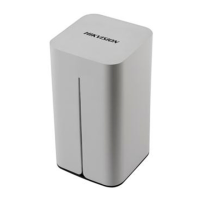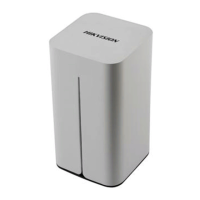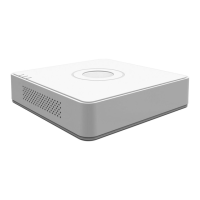
Do you have a question about the HIKVISION DS-7108NI-SL and is the answer not in the manual?
| Brand | HIKVISION |
|---|---|
| Model | DS-7108NI-SL |
| Category | Network Hardware |
| Language | English |
Provides information about the manual's applicability and subject matter.
Acknowledges Hikvision's trademarks and those of other companies.
Outlines the legal limitations and responsibilities regarding the product's use.
Details FCC compliance statements and conditions for digital devices.
Explains CE marking and compliance with European directives like WEEE and battery directives.
States compliance with Canadian ICES-003 standards for digital apparatus.
Highlights critical safety precautions to prevent serious injury or death if neglected.
Lists general features like connectivity to network cameras and dual-stream support.
Describes features for on-site monitoring, including HDMITM/VGA outputs and live view functions.
Details HDD connection, capacity limits, and management features like S.M.A.R.T. detection.
Covers scheduling, recording types, and pre/post-record settings for video capture.
Explains how to export video data and manage backup devices.
Details configurable alarm triggers and response actions like notifications and email alerts.
Lists local operational features such as user management and configuration import/export.
Describes network interfaces, protocols, and connectivity options like P2P and DDNS.
Mentions SDK availability and development support for system integration.
Describes the control panel buttons and interfaces on the front of the NVR.
Explains how to use the infrared remote control and its key functions.
Details how to use a USB mouse for NVR navigation and control.
Describes the soft keyboard layout and button functions for text input.
Illustrates and describes the various ports and connectors on the rear panel of different NVR models.
Explains the correct procedures for powering the NVR on and off to ensure device longevity.
Guides users through setting an initial administrator password for device activation and security.
Details the setup wizard for configuring essential NVR settings like date, time, and network.
Explains the process of logging into the NVR to access its functions and how to log out.
Guides users on adding, activating, and connecting network cameras to the NVR.
Details how to activate IP cameras to ensure they are in an active status before adding them.
Guides users on how to add network cameras to the NVR for live view and recording.
Explains how to modify IP camera parameters and set up custom protocols for connectivity.
Details editing camera connections for PoE or built-in switch interfaces, including disabling PoE.
Shows how to view the status of PoE ports, including connection status and power consumption.
Explains what live view is and describes the icons used to indicate status on the live view screen.
Details various operations and controls available within the live view mode.
Describes mouse operations for navigating and controlling the live view interface.
Details the quick setting toolbar available on each channel for immediate access to functions like recording and zoom.
Guides on customizing live view settings like output interface, dwell time, and audio.
Explains how to log out of the NVR, returning it to live view mode.
Details how to set up PTZ parameters, including RS-485 settings, before controlling PTZ cameras.
Covers setting PTZ presets, patrols, and patterns for automated camera movements.
Guides on setting preset locations for PTZ cameras to point to specific positions for events.
Explains how to activate a preset position to make the PTZ camera point to a specified location.
Details how to set up patrols by defining key points and dwell durations for PTZ camera movement.
Explains how to activate a patrol path to move the PTZ camera according to predefined sequences.
Guides on setting patterns by recording PTZ movement for later playback.
Explains how to activate a stored pattern to move the PTZ camera along a predefined path.
Details how to set linear scan limits for horizontal movement within a predefined range.
Explains how to activate the linear scan function within the defined range.
Describes how to configure a park action that activates automatically after a period of inactivity.
Describes how to access and use the PTZ control panel for camera movement and settings.
Guides on setting recording parameters like stream type, resolution, and quality for optimal image capture.
Details how to set up recording schedules for cameras, including continuous, event, and custom time periods.
Explains how to set up motion detection areas, sensitivity, and trigger recording or other actions.
Describes how to configure alarm inputs and set up recording or other actions when an alarm is triggered.
Details how to set up VCA (Video Content Analysis) alarms and trigger recording or other responses.
Explains how to manually start and stop recording, overriding scheduled recordings.
Allows setting specific recording schedules for holidays throughout the year.
Explains how to enable redundant recording to save data on both main and secondary HDDs for reliability.
Details how to group HDDs and assign specific channels to record onto those groups.
Describes methods to protect recorded files by locking them or setting HDDs to read-only.
Covers methods for playing back recorded video files.
Guides on playing back recorded video for a specific channel, including instant playback.
Explains how to play back video files recorded at a specific time, supporting multi-channel playback.
Details how to search and play back video files based on event types like alarm or motion detection.
Explains how to add and use tags for searching and locating specific video segments.
Describes smart playback, which prioritizes motion or VCA events, playing them at normal speed and others faster.
Explains how to play back video files associated with system log entries.
Guides on playing back files stored on external devices.
Covers additional playback functions like frame-by-frame viewing and digital zoom.
Explains how to play back video frame by frame for detailed image inspection.
Describes how to use digital zoom on playback to magnify specific areas of the video.
Details how to play back video from multiple channels in reverse simultaneously.
Covers methods for backing up recorded video files to various devices.
Explains how to quickly export record files to backup devices like USB drives.
Guides on backing up files found through normal video search using various devices.
Explains how to back up event-related record files using USB devices or SATA writers.
Details how to export selected video clips during playback to USB or SATA devices.
Covers management of backup devices like USB flash drives, HDDs, and writers, including formatting and deletion.
Guides on setting up motion detection areas, sensitivity, and configuring alarm response actions.
Details how to configure handling actions for external sensor alarms and set arming schedules.
Explains how to detect video loss and configure alarm response actions and arming schedules.
Guides on detecting video tampering, setting sensitivity, and configuring alarm response actions.
Details how to detect VCA alarms from IP cameras and configure alarm response actions.
Explains how to configure handling actions for various system exceptions like HDD full or network disconnection.
Describes various alarm response actions, including event hint display, full screen monitoring, and audible warnings.
Explains how to manually trigger or clear alarm outputs from the NVR.
Guides on configuring general network settings like IP address, subnet mask, and DNS server.
Covers advanced network configurations including P2P, DDNS, PPPoE, and NAT.
Details how to enable EZVIZ Cloud P2P for remote access via mobile app or web platform.
Explains how to configure Dynamic DNS (DDNS) for network access using various DDNS types.
Guides on configuring PPPoE settings for dial-up access over Ethernet.
Details how to configure the NTP server for time synchronization across the network.
Explains how to use SNMP protocol to get device status and parameter information.
Describes how to configure a remote alarm host to receive alarm events or exception messages.
Details how to configure multicast for live view connections exceeding 128 users.
Explains how to configure RTSP port for streaming media servers.
Guides on changing server and HTTP ports for remote access.
Details how to configure email notifications for alarm events or system changes.
Explains NAT configuration for remote access via UPnP™ or manual port mapping.
Guides on checking real-time network traffic information, including linking status and rates.
Covers network detection methods like delay testing and packet export.
Explains how to test network delay and packet loss to diagnose connectivity issues.
Details how to export captured network data packets for analysis.
Guides on checking the current network status and parameters.
Explains how to check network statistics and bandwidth usage.
Guides on initializing newly installed HDDs before they can be used with the NVR.
Details how to add and manage network HDDs like NAS or IP SAN disks.
Covers managing HDDs by grouping them for storage and recording assignments.
Explains how to group multiple HDDs for managing storage and recording assignments.
Guides on setting HDD properties like redundancy, read-only, or read/write for data safety and reliability.
Details how to configure quota limits for each camera's storage capacity.
Explains how to check the status of installed HDDs for potential failures and maintenance needs.
Covers HDD detection methods like S.M.A.R.T. and bad sector scanning.
Guides on using S.M.A.R.T. technology for HDD monitoring and failure anticipation.
Details how to perform bad sector detection on HDDs to check for surface errors.
Explains how to configure alarms for HDD errors, such as uninitialized or abnormal status.
Guides on configuring OSD (On-screen Display) settings for cameras, including date, time, and camera name.
Details how to set up privacy masks to block specific areas from being viewed or recorded.
Explains how to adjust video parameters like brightness, contrast, and saturation for camera images.
Covers viewing system information, including device details and network status.
Guides on viewing system information, including device details, firmware version, and network status.
Details how to search and export system log files for troubleshooting and auditing.
Explains how to import/export IP camera configuration information via Excel files.
Guides on exporting NVR configuration for backup or importing to other NVRs.
Covers methods for upgrading the NVR system firmware.
Details how to upgrade the NVR firmware using a local backup device.
Explains how to upgrade the NVR firmware using an FTP server.
Guides on restoring NVR settings to factory defaults or an inactive status.
Details how to configure the RS-232 serial port for parameter configuration or transparent channel communication.
Explains how to configure general interface settings like language, resolution, and time zone.
Details how to configure Daylight Saving Time (DST) settings for automatic time adjustments.
Guides on configuring additional device parameters like name, number, and auto-logout settings.
Covers managing user accounts, including adding, deleting, and editing.
Details how to add new user accounts with specific permissions and levels.
Explains how to delete existing user accounts from the NVR.
Guides on editing user account parameters, including password and permissions.
Provides definitions for technical terms and acronyms used in the manual.
Offers solutions for common issues like no image display, audible warnings, or IP camera connection problems.
Lists the changes and updates made in different software versions of the NVR.
Provides a comprehensive list of IP cameras compatible with the NVR.
Lists third-party IP cameras compatible with the NVR, noting ONVIF and AXIS support.











